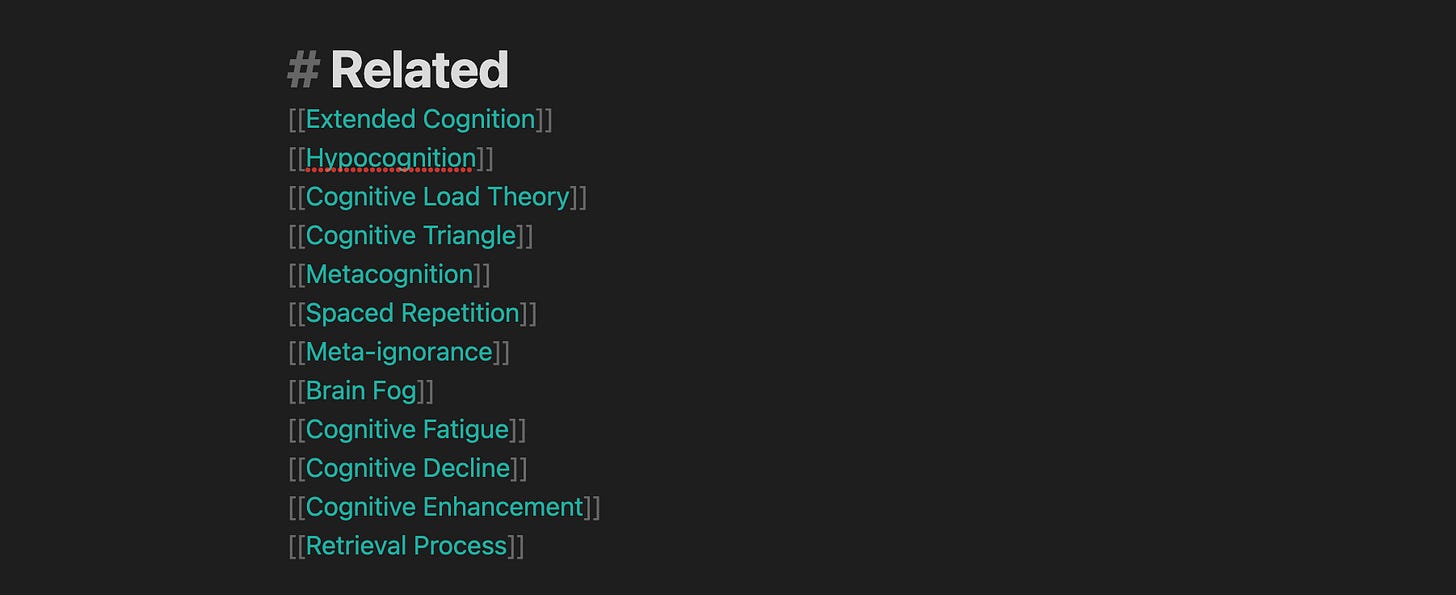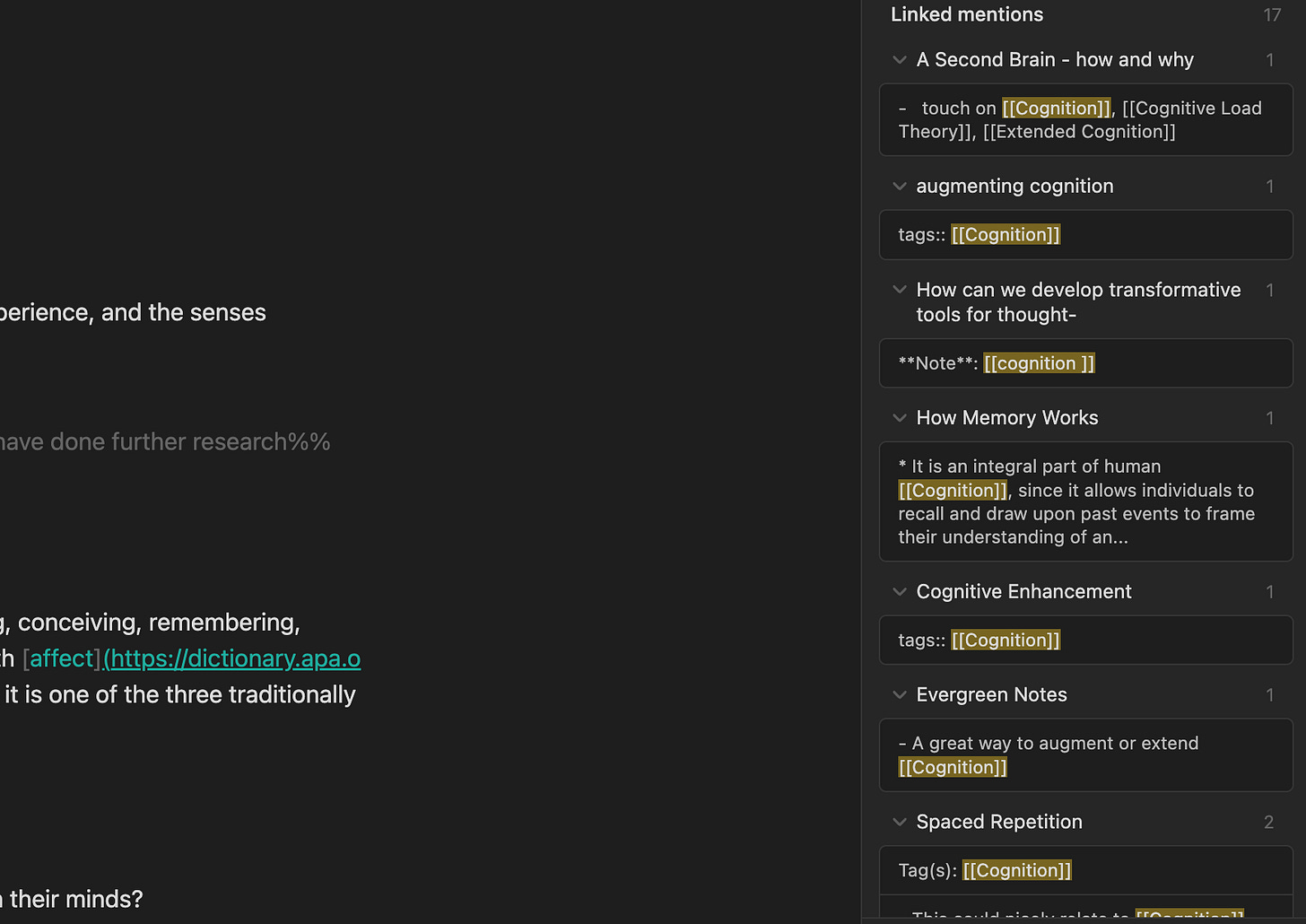Atomic Notes
A tool for augmenting your mind
We have all had a moment when we wanted to recall something and we just couldn’t. Maybe you had this topic written down in a journal, on a document, or in a note-taking tool, but you just didn’t know where to start. So you type in term after term in search and it comes up with nothing relevant. The problem with augmenting our minds, is that most of us don’t do it efficiently. We either don’t know where to start or have a system that isn’t structured to search through it.
A system that is flexible and scalable is atomic. What am I talking about here? A simple concept called atomic note-taking.
What is atomic note-taking? Simply not putting all concepts and information in one artifact, in this case – notes. It is breaking up information over multiple notes.
As an example:
If you are doing research on cognition, don’t write all the raw information about general cognition, extended cognition, cognitive load theory, and metacognition in one note. If you wanted to single in on one idea in these notes, it would be very hard to find. It would also be less valuable if you wanted to retain this information over time because there would be too many concepts in this note.
The best way to handle this would be to break up this note into each concept. The main note is cognition but then links to each sub-concept. This way the information is contextually surfaced while allowing for deeper information as needed. Additionally, when needing to search for this information over a period of months or years, you can then easily search for any of the concepts, following the links back to one another.
At this point, you are thinking why the hell should I care? Well, that depends on your need for notes, but more largely, this idea can be scaled to many things. I am passionate about note-taking, due to my memory being a bit overloaded. As a lifelong learner, I love to understand ideas and concepts, and reference them over time. You may not be this type of person and that’s 100% fine. But we all need to learn things from time to time and the human memory kinda sucks. Types of information are encoded differently and for varying durations of time. So instead of depending on your memory solely, why not augment it – right?
Ok, well if you don’t care about notes, you can apply this to other things too. Atomic projects, atomic tasks, even atomic shopping lists. Breaking up information into smaller chunks allows us to process them better and get to them with ease. It provides additional context to things allowing our brains to form deeper connections with them.
Back to atomic note taking and how it can lead to deeper learning and more efficient recall. How do you accomplish this? Do you need a paper notebook, can you use Apple Notes or Google Keep? Well yes, you can totally use any of these. You can also use index cards or stickies. The entire system, called Zettelkasten, was built on atomic notes on slips of paper. Niklas Luhmann wrote 70 books and 400 articles using this method.
In the modern era, doing this manually seems a bit counterproductive. I recommend using a tool for networked thought. There are a ton of tools for this, the category is blowing up right now. The OG of networked thought is Roam Research. Since then, there are faster more focused tools. If you want a jack of all trades, Notion can feed the need. If you want a solution that is node-based like Roam, you can go with Logseq, or the new kid – Tana. There is also Obsidian, a note-based tool.
There is a difference between node and note, it’s not a typo. Nodes are generally bullets with nested information. Notes are single notes linked to other notes.
I recommend something that is adaptable to your needs and can be accessed wherever you are. If that is at home, at work, or just out and about. All of the tools I have mentioned have mobile apps. All of these tools do vary a bit, so do some due diligence to find the one best for you at home and on the go.
I plan on going into the weeds about the differences between Obsidian and Notion in the coming weeks. If you are interested in learning more about that, let me know.
Regardless of which tool you choose, I recommend selecting something that offers bi-directional linking. If you want linking to be as seamless as possible, I recommend using something that supports markdown.
What is bi-directional linking? Simply linking notes to one another. In markdown, this is done simply by wrapping a text string in [[]]. Going back to that example about cognition, you would simply type [[Metacognition]] into the “Cognition” note. This will form a bi-directional link, so you can navigate between them easily. It also allows you to link that term at will, so you don’t have to redefine it in multiple notes.
Linking is a valuable concept because it supports atomic note-taking perfectly. This is doable without a tool that supports it, but you will have to find a way to force structure to files without it. If linking is built in you can write at the speed of thought.
So you’ve picked a tool, but how do you actually take these notes? Firstly, find a topic that interests you. Do research on it. Look for articles, research papers, social posts, etc. For everything that is of value, make a separate note for each source you plan to take note of. Then add whatever metadata works best for you. This could be the URL, a link to where the raw file is stored, the date created, or whatever.
Then you’ll take notes about each source. Important - do not clip the entire article or video into the note. Only add notes and highlights that are very important or captured your interest. Having the entire body of content copied might seem useful, but it makes referencing your notes hard over long periods of time.
Next, you should create a note on the topic you are learning about. You can link these notes together using the bi-directional links I mentioned above. This will form a connection between them. Fill in the topics note with your thoughts, ideas formed, and lessons learned. Having your opinion and the facts all linked together will make this note 100% more valuable when you need to reference it.
There are numerous methodologies related to this style of note-taking. I mentioned Zettelkasten already, the use of atomic notes linked to each other. Zettelkasten also adds in the hierarchy of daily notes, literature notes, and sources. Digital gardening is also popular, as this play on the idea of tending your knowledge over time. There is still the atomic structure, but the concepts of seeding, budding, and evergreen come into play. These are the stages of fidelity of your thoughts on the topic. Andy Matuschak talks a lot about the concept of evergreen notes.
I also plan on going a bit deeper on Zettlekasten and Digital Gardening in the coming weeks.
Atomic note-taking has been extremely valuable to me. I felt like I needed to share the basics of the concept and the supporting tools and methodologies to possibly help some of you augment your minds efficiently. You don’t need to follow any of this to gain huge value. Simply changing how you think about information, in an atomic format, can make a big difference. If you have any questions on the topic let me know by commenting below or replying to the email.
Upcoming editions (not in this order or naming convention)
Zettelkasten
Digital gardening
Networked thought
Notion vs Obsidian
Subscribe to Async Chats! | Follow on Twitter | Newsletter Feedback Form



